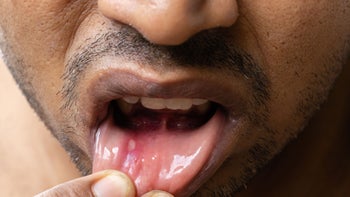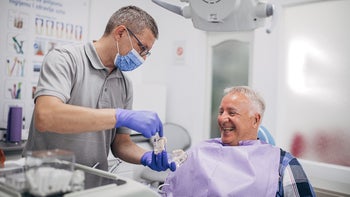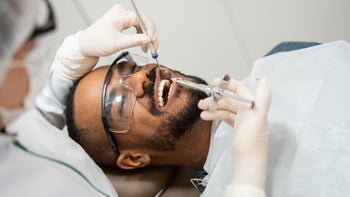
Gum Graft Surgery: the Procedure, Recovery, and What You Can Expect
Key takeaways:
Receding gums can cause tooth sensitivity, decay, and loss. Gum graft surgery treats gum recession and prevents its complications.
A gum graft is usually taken from the roof of your mouth. In some cases, the graft may be taken from an outside source if your dentist finds it necessary.
Gum grafting surgery is not painful, but it has a recovery time of at least 2 weeks. And it may take 4 to 6 weeks to recover completely.

Are you struggling with receding gums? If so, you’re not alone. Almost 25% of adults in the U.S. have gum recession.
Gum recession can be very uncomfortable and even painful. When your gums recede, the roots of your teeth can become exposed. This makes the teeth sensitive, and it may even create gaps between them.
But there is good news. Gum graft surgery is a safe and effective treatment that helps restore the gum line. This procedure helps protect your teeth and makes your smile look better.
Search and compare options
Who needs gum graft surgery?
Gum graft surgery may be recommended for people who have receding gums. This is a common condition that occurs when the gum tissue pulls back from the tooth, exposing the root. Gum recession can lead to tooth sensitivity, decay, and loss if left untreated.
Receding gums can happen due to many factors, including:
Gum disease
Genetics
Aggressive brushing habits
Tobacco use
Hormonal changes
Lip or tongue piercings
Irregular tooth position
In some cases, gum grafting may also be recommended for cosmetic reasons. Your dentist or periodontist (gum tissue specialist) can evaluate you and decide if gum graft surgery is the best option for you.
How does a gum graft work?
Gum grafting involves taking gum tissue from one part of the mouth (usually the roof), and using it to cover exposed tooth roots. The gum tissue may even be taken from a donor if your dental provider thinks it’s necessary to do so.
The procedure typically involves four steps:
Anesthesia: Your dental provider may start by giving you a light sedative: nitrous oxide, also known as “laughing gas.” Your teeth and gums are then numbed with local anesthesia.
Site prep: Your provider will then prepare the area where the gum graft is being placed. This includes a deep cleaning of the exposed roots to help the gums reattach.
Harvesting the graft: The surgeon will then harvest your gum graft. This is done by making a small incision on the roof of your mouth and taking a portion of gum tissue large enough to cover the affected area. (If your surgeon decides to use a graft from an outside source, this step will be skipped.)
Placement: The gum graft is then placed on the affected area, secured with sutures, and covered with a healing dressing.
Over time, the grafted gum tissue will connect to the existing gum tissue. New blood vessels will grow to give life to the newly grafted gum tissue, and it will become thicker and stronger as a result of the new blood flow. This will help to protect your teeth from further damage and sensitivity.
How painful is gum graft surgery?
Although dental surgery can be intimidating, the good news is that gum grafting is not considered a painful procedure. Your dentist will give you anesthesia before the procedure to ensure you don’t feel any pain during the surgery.
You may experience some discomfort and sensitivity in the days following the procedure. But you should be able to manage it with over-the-counter pain relievers and good oral hygiene practices. Your dentist will provide you with specific instructions based on the extent of your surgery.
How long does it take to recover from gum graft surgery?
The recovery time after gum graft surgery can vary. The amount of time it will take you to recover will depend on the extent of your procedure and your body’s natural healing ability. Most people can expect at least 2 weeks of initial healing, and about 4 to 6 weeks to recover completely.
Your dentist will have you come back to their office 1 week after the surgery to have the stitches removed. They will also ensure that the gum graft is healing properly and that your body is accepting the newly grafted gum tissue.
What are the possible complications of gum grafting?
Gum graft surgery is generally a safe procedure. But there are several complications that can occur. These include:
Swelling and bruising in the treated area
Bleeding from the surgical site (especially in the first few days after surgery)
Delayed healing (if the graft does not integrate properly)
Nerve damage
Are there any alternatives to gum graft surgery?
There are a few nonsurgical alternatives to gum grafting. But they are best used as early treatments, when your gum recession is minimal. Here are two options to consider:
Scaling and root planing: This nonsurgical treatment involves deep cleaning the affected teeth and gums. The removal of plaque and buildup helps promote the growth and attachment of healthy gum tissue.
Prevention and management: In some cases, you can manage minor gum recession with good oral hygiene practices. These include brushing and flossing regularly, not smoking, and avoiding acidic foods and drinks.
Your dental provider can provide specific recommendations for you based on your individual needs.
The bottom line
Realizing that you’re experiencing gum recession can be worrisome. However, you can take comfort in knowing that gum graft surgery is a safe and effective remedy. It’s a painless procedure with a quick recovery, so you’ll be back to your normal routine in no time.
If you’re not sure that gum grafting is the best treatment for you, speak with your dental provider about possible alternatives. They can help you figure out the most appropriate course of treatment.
Why trust our experts?


References
Chan, H., et al. (2015). Does gingival recession require surgical treatment? Dental Clinics of North America.
The Journal of the American Dental Association. (2007). Gingival recession: Causes and treatment.

























